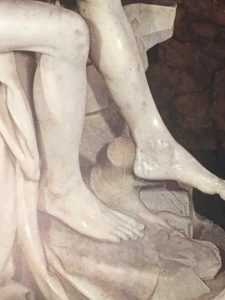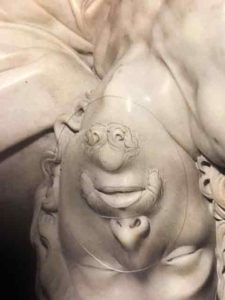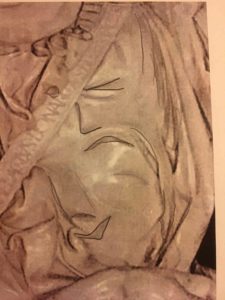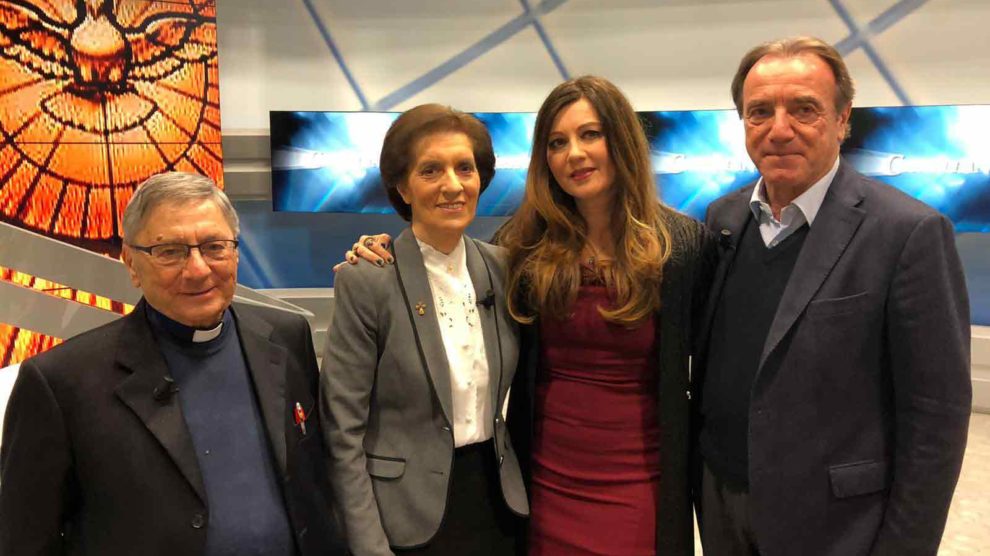Michelangelo’s Pietà and Sanmartino’s Veiled Christ are two masterpieces that, despite being made in different historical periods, represent examples of sculptures that sink the root in an archaic vision with multiple wisdom elements in common. Both sculptors belonged to top-level corporatist initiatory schools, both were great specialists of human/spiritual anatomy and the work of Buonarroti greatly influenced the Author of the Veiled Christ.
Michelangelo painted the Pietà at just over twenty years old but by the time he already had deep knowledge. He applied himself as a child to the study of classical texts and in Vitruvium learned that man is the highest example of unity, balance and the human body is God’s highest creation. His fondness for the male nude stemmed from a philosophical factor, and the Hellenic-Platonic exaltation of the human body was an important element for the return of the ancient. He performed, for example, the resurrected Christ as a naked Apollo, and the Laocoonte of Apollonius of Athens was for him the greatest expansion of perfection as well as the Belvedere Bust. He believed that the naked of man as the naked stone represented pure perfect “Intelligence“, without the need for decorative tinsel. He learned from the Ficino that the body is infused with Light, so man as the stone is matter and Spirit and the true sculptor is not who makes mathematical or prospective calculations but the one who has the divine proportions in his eyes. The idea of the Platonism that most inspired Michelangelo was that inside the rock as in man there is a latent image waiting to be discovered put in place by the sculptor “in Concept”. The otherworldly world creates a form within matter and the real artist manages to penetrate the true preordained silhouette outside of time through Intelligence, so the image foreshadowed in stone is considered as evident even before being freed from his marble prison. The function of the artist therefore was to adapt “matter” and “concept” and the effort to translate into work a “concept” attracted Michelangelo more than the practical finishing that he often left to his students, limiting himself to setting preparatory drawings. The conceptual aspect is therefore eternal, so not only will the archetypal form last forever in the empire, but it will also persist the derived form that, as an imitation of the first, is part of its immortal nature. The consequence is that already in the marble quarry the eye of “who sees” can see the work in power and Michelangelo loved to mark marble blocks to distinguish them from others who had no Spirit. The sculpture was therefore for Michelangelo a form of service to God and a trait d’union between the moral ideals of Christianity and the perfect forms of the classical world.
The Pieta is the only work finished and signed by Michelangelo who did not like to finish his sculptures to better protect this “concept” and not unveil it as a mystery. The signature is present in the band that crosses diagonally the torso of the Virgin. The initials of the Buonarroti are also present in a hidden way: the M is in the chest of Our Lady and the B comes from the game of veils that is formed through the legs of Her concealed by the veil. (Figure N. 1)
Comparing the two works, what stands out is that both are dedicated to piety because San Severo Chapel is also called St. Mary’s of the Piety or “Pietatella” (transl. = Little Pity), which in both Christ is gracile and delicate and that one has a veil and the other does not. This is a requirement that differs from the usual male sculptures sculpted by Michelangelo who also used manly bodies to depict female limbs such as the Sibyls. In the Pietà, on the other hand, the body of Christ is of a man who has nothing manly and this detail is rather relevant. Another clue to highlight is that considering Michelangelo’s idea of “concept” why is the Pietà unlike the other sculptures of Renaissance genius a manifest and revealed work? The unfinished allows an interpretative ambiguity, here instead the work is unveiled, although as we will see only in appearance as it hides details that misunderstand from the falsely revealed. Another question is why is Mary the mother younger than her son? Moreover Michelangelo did not like the theme of death very much, his religiosity was vitalism but the Pietà is a drama in the drama. She has a grieving look weeps (perhaps an unconscious influence of Savonarola head of the sect of the “Piagnoni” [transl. = whining] as they all cryed during the sermons), but a clue reveals that it is not so as Her plastic garments are an opulence of veils that follow each other, waves of the sea that refract on rocks and then return to themselves. Michelangelo is an evident contrasts lover: She is younger than him and represents the opposition of the movement to stasis, the profane become respect to the crystallization of dogma. She is the whole: rock on which she is sitting becoming a one with it and spiritual movement at the same time. The work is therefore the depiction of the two polarities: life and death.
Michelangelo’s Christ does not have a veil as opposed to the veiled Christ.
The veil is like a mirror of light that is reflected, but the back of it is black and analogous to a darkroom that absorbs the light of the reflected image, reworks it to revive a new image.
The Veiled Christ radiates brightness from the inside in a game of mirror with his veil, as if his very intense light remained potential, the Pietà instead with its polished marble is dazzling: it is the light that is reflected from the stone in which it creates and reproduces the image. The Veiled Christ is therefore a “perpetual lumen“, a perennial unexploded light, like the perennial lamps that usually burned at the statues of Athena or Venus and that represented the spiritual fire that never died out. Pietà is also a perpetual lumen, but the veil that mirrors Christ is hidden, as we will see later. Wearing the veil means getting wet with the Holy Spirit as in classical antiquity where through the veil “the motion motionless” was reproduced. Let us think back to the veil of Our Lady in the Pieta, She moves despite being rock. The veil is therefore the dissimulation of secret things, the unveiling as a revelation of light that makes immortal when we can see in to ourselves. It is a mirror that refracts our interiority but to understand who we are we must go further, into the darkness (dark room), where the light we have reflected creates the true image: our perpetual lumen.
The veil is therefore the “motion motionless” that follows the same principles of “everything flows” and that with the same laws will rise from the rock. The symbol is the circle present in the crown of thorns at the foot of the Veiled Christ, the three iron nails two of which are crossed as a sign of union and then a pair of pincers whose meaning is to take but also conceive. These elements are important symbols related to the alchemic phases of rebirth.
The mirror is a symbol of the Sun of Isis which is beautiful in appearance but with the divine Self and the higher Self even brighter. The search for beauty is analogous to the search for the Grail because if it were not hidden and mysterious, it would not be perceived. The reflected image represents the sacred wedding between the complexion and the spirit of light. This means that the Veiled Christ is as beautiful as Isis or Venus because she has the divine Spirit of the sacred feminine in Her and to look at it well is very feminine. Originally, the sculpture of Sansevero’s Chapel was not placed in the center but very close to the veiled goddess (the veiled Demureness) wrapped by the branch of roses with at the foot the cup of the Grail placed on the left of Christ. On the right was and is depicted another statue an angel child a flame on his head and a man trying to free himself from a veil that has the shape of a torn net. (The Deception) Matthew writes that at the instant of Christ’s death the veil will be torn from one end to the other. The two statues are currently placed to the left and right of the veiled Christ as if to form a Vav with the tip facing down, whose tip is exactly Christ. Therefore, the last stages of the alchemical path (the three sculptures are those donated to the San Severo’s Chapel by Raymond of Sangro, the great alchemist and Neapolitan Master devoted to science and the arts) summarize the transformation process. Thanks then to the goddess completely wrapped in the veil symbol of nature and the pink mystical symbol of the Rosicrucians that Christ will be able through the flame of the Holy Spirit to free himself from the network of the illusory matter that is reflected in the veil/mirror and unveil his real image and therefore his true Self.
Behind the statue of Christ veiled in the background of the chapel there is a sculptural painting in which the Christ is depicted, the Magdalene weeping with her cup that is the point of union of a heart that the sculpture creates through the bodies of the two espouses. Above the image of the Magdalene there is the V of the Jewish Vav symbol of marriage, while at the foot of the couple we find the rock, the tree with roots, a mountain and a cave inside the angels hold Veronica: the veil with the Christ image. It is the soul of the stone that has become flesh, like the man who according to mythology is clay kneaded with water that is crystallized, as happens with stones. This could be the alchemic process studied and re-proposed by Raymond of Sangro for the creation of the veil of Christ who still amazes how it was possible to realize it.
In Greek the word veil has the same origin as the cup of the envelope, the rose bud and the grail, which is why the veiled Christ is very puny almost female, since it is the spirit inside the cup that contains it and the detail that reveals this statement is the fold of the lapel of the veil that envelops it that allows glimpse another concealed presence: a embroidered hem like the veils usually decorated for the Godness of Wisdom. So She is the secret part and the essence of Him, the only mediator, and that is why Christ is delicately beautiful. We know that where the San Severo Chapel now stands has always been a mystical and pilgrimage site to the worship of the Great Mother, let us not forget that it was originally a temple dedicated to Isis. We will see how this Godness is the point of further contact between the two works.
Looking carefully at the hidden aspects of Michelangelo’s work, two figures are hidden near the chest and heart of Our Lady: a man and a woman. (Figure N. 2) The man has a beard and a veiled head in a priestly and authority, within the same beard that has the shape of a heart there is a female figure also wearing a veil. Given therefore that Christ is greater than the Mother it is very likely that the two carved figures were not mother and son but rather a married couple. Both are authoritative figures because of the veil (symbol of temporal and spiritual authority) but to look closely also the two sculpted bodies have in themselves the same message: the right hand of Christ has the sign of the Jewish Vav that is a symbol of covenant and union, even if reversed, the left hand is closed so there is an undisclosed secret and the thumb touches the ring finger, the finger of the conjugal union. The subtle and manifest symbolic detail is the right foot of the man who has the longest malleolus, in sign of auctoritas tied to the origin but also the left hand of Our Lady has the index finger of the longest hand also therefore regal, indeed it is even more so since the left hand is tied to the supernatural while the foot is tied to an earthly auctoritas.
As in the Veiled Christ, the married couple in the Pieta recreates the mystical union of the sacred wedding and then the recomposing of matter and its “concept” in the marble block. Both espouses recognize the Roman Pietas, the deity responsible for fulfilling their duty to the State, divinity and the family.
The Buonarroti’s Christ has an extra tooth: the incisive that is the symbol of sin but for the Celtic world having an extra tooth meant having pure divine essence.
His body is puny and being for Michelangelo as for the Renaissance all symbolic and believing that man has in the power of his forms the universal breath, the solution of the dilemma could invoke the fact that the carved subject was “Son of Man” and this name could be referred to Jesus as it is written in the Gospel of Matthew, but also to Caesar who was a man not overly manly.
It is known that Rome accepted Christianity as the religion of the empire with Constantine on the basis that Jesus was an imperial Roman, as evidenced by the Mandei who speak of “Christ the Roman.” Therefore the woman could be Magdalene undoubtedly linked to Egypt, or the body of lifeless Caesar in the arms of Cleopatra invoking the fact that the structure of the sculpture is pyramidal and on the head of the Woman there is a frieze created with the veil that could represent the third eye or the mirror typical of the Egyptian goddess. This detail makes it possible that even the Christ of Pieta is a perennial lumen thanks to the veil/mirror present on the forehead of the Mother/Isis who looks at him. Continuing to examine the possible identity of the married couple linked by a love for pietas and therefore for divine duty and not by conjugal love (remember the inverted Vav of the right hand of Christ) it is well known that the initial location of the Pieta was the Santa Petronilla’s Chapel in the early basilica of the present St. Peter but what matters is the place where the construction that tradition counts as the burial temple of the jens Julia. Nevertheless, Caesar after so many wars of purge and regulations introduced the concepts of forgiveness, magnanimity and brotherhood among the citizens of the same state and finally the passion of Christ is similar to that of the divine Caesar after his assassination.
Michelangelo’s work contains the same elements evident in the veiled Christ, although much more hidden: the mystical couple manifests and hidden, but also the great Mother who is the same Madonna who has in her head the solar mirror typical of the goddess Isis in the shape of pyramid, there is the rock and the cut tree.
The great difference is that the couple present in the veiled Christ is covered by the veil and also in the altar at the bottom of the chapel Christ and Magdalene are inside the heart within a veil, in the Pieta instead apparently only the Woman is veiled in the body but in the pair hidden both have the veil only on their heads. In the Christian world the veil is reserved for nuns, as opposed to the Jewish world where the veil is a symbol of social, religious and political authority for both women and men. Even in ancient Rome, the highest dignitaries of the State, the paters of the Senate wore the veil during the rites, as well as the Roman matrons and dressing swear men. From these considerations it can be assumed that in the Pieta, Michelangelo wanted to represent a pair of very powerful characters related to the Empire and the Egyptian cult. The fact remains, however, that the Christ of St. Peter is without a veil and this could represent the “lie” as if to suggest that the truth could be something else. A peculiarity is that turning the face of Michelangelo’s Christ appears ati little man with an attitude of joking ridicule. Below is the shape of the heart procured from the inverted nose of the Christ. (Figure N. 3 ) For Christianity, being the truth hidden from all men, the veil falls only through death, but in the specific case of Pieta death is not victory, man is no longer there and perhaps the victory of the resurrection is precisely Her, the Goddess Mother Isis whose shape of the pyramids is also the form of the Mount of Victory (again there is a parallel with the Christ present in Veronica that means procuring victory) that like a cave collects the spurts of his son and his husband. The triangle therefore means that the Trinity is represented in both the Pieta and the Veiled Christ (through the last three statues of the alchemic path, summarized by the final sculptural image at the bottom of the chapel).
An element of reflection is that the word Peter or Petronilla comes from stone whose word comes from Pel (transl. = skin). By associating the stone with the word soul that derives from Gal and putting together as a palindrome the two words form Pelago the first being embodied in a place in Rome now Vatican City which is the place of the origin of a particular jens in which in pre-Christian times there stood the temple dedicated to the Goddess Minerva the Wisdom.
If we then go to mark the path of the silhouettes of the bodies as they are arranged in the Pieta, it comes a swastika counterclockwise. For insiders it is known that this symbol was archaic among other things of Jewish origin and means to be lucky, fair and good.
Another reflection is that the Hebrew word Jesse (Mary) means the lineage of fire so the Sun is the Jes. Jesus is therefore the one who originates from the Sun. If we take the word Israel means (Hel) the female god is the Sun (Ra) Isis (Is). Therefore, man cannot ignore the feminine solar sacred Spirit, which is the only one that communicates with the Sun. Michelangelo knew very well this archaic culture since he had studied at the Guilds, the initiatory schools to mysteries in the period of the Renaissance.
The female fire is also hidden in a place of sculpture not obvious but essential. We know that the mirror gives an inverted image of reality so in the Pieta is depicted a Christ whose real portrait is lifeless but in truth becomes immortal in the mystical couple hidden in the pyramid. The mirror therefore does not just reflect, the Soul participates in the image and through this participation undergoes a change. The point of transformation is symbolically represented by the heel of Christ that touches the branch of the broken trunk. At death the soul goes away through the heel which is the base of the erect body. At the point where the tree is cut and not broken, as the net cut is wanted by human hand symbolizing an assassination, a new life will sprout. (Figure N 4) The foot of the heel that touches the branch is the “regular” foot not essentially what represents the power of origin, but the human one. The Pietas of the Mother, which is the duty in the fulfillment of the fulfillment of principles and Justice, all reabsorbs (death) and everything re-emerged (life). It follows that the tomb of Him is also his Mother who holds him in his arms and welcomes him back but it is also she who will be reborn and the “little king” reborn will become a real mother because in him there will always be Her because the gold of his seed will always be reborn. If the grain of wheat does not fall to the ground and moves, it remains sterile, if it dies it bears fruit, for this reason in the death of the son is reborn the mother who gives him life and death or better life and transformation. On Her forehead the mirror that reflects an image of death actually already thinks of life through the fire (and here is the perennial light even in Christ without the veil of Pieta). The lifeless character is therefore destined to continue and pass on the origin, his Imperium.

detail linked to the resurrection in Michelangelo’s Pieta
The Pieta that reflects apparent sadness and compassion is actually the AMOR (translation from Italian: “LOVE”) rebirth, the duty to fulfill principles of life, the secret name of Rome: “without death” that does not believe in the end and this is a message, a summation of Renaissance knowledge. It is the ode to the life of the great Michelangelo who, with chisel blows, will nullify his ego, so much so that he becomes himself the secret Soul of the stone and therefore of the eternity.
Data Sheet:

Funny man laughing with heart underneath deriving from the upside down nose of Christ.
Artwork: Pietà
Author: Michelangelo Buonarroti.
Polyto marble group height 1,74 m, base width 1,95 m.
Year: 1498/99 commissioned by French Cardinal Jean Bilherès de Laugraulas at the court of Pope Alexander VI.
Original location: Rome, Sistine Chapel Petronilla of the ancient Constantinian Basilica.
Current location: Vatican City, St. Peter’s Basilica.

Mystical marriage can be seen The loving intertwining inside an egg. Both wrapped in the veil symbol of civil and religious and spiritual authority
Artwork: Veiled Christ
Author: Giuseppe Sanmartino
Year: 1753
Marble size: 80x80x50 cm.
Location: Naples, San Domenico Maggiore Square. San Severo Chapel Museum.


Comments are closed